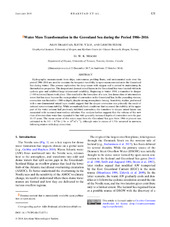| dc.contributor.author | Brakstad, Ailin | |
| dc.contributor.author | Våge, Kjetil | |
| dc.contributor.author | Håvik, Lisbeth | |
| dc.contributor.author | Moore, G.W.K. | |
| dc.date.accessioned | 2020-03-25T13:25:02Z | |
| dc.date.available | 2020-03-25T13:25:02Z | |
| dc.date.issued | 2019-01 | |
| dc.identifier.issn | 0022-3670 | en_US |
| dc.identifier.issn | 1520-0485 | en_US |
| dc.identifier.uri | https://hdl.handle.net/1956/21589 | |
| dc.description.abstract | Hydrographic measurements from ships, autonomous profiling floats, and instrumented seals over the period 1986–2016 are used to examine the temporal variability in open-ocean convection in the Greenland Sea during winter. This process replenishes the deep ocean with oxygen and is central to maintaining its thermohaline properties. The deepest and densest mixed layers in the Greenland Sea were located within its cyclonic gyre and exhibited large interannual variability. Beginning in winter 1994, a transition to deeper (>500 m) mixed layers took place. This resulted in the formation of a new, less dense class of intermediate water that has since become the main product of convection in the Greenland Sea. In the preceding winters, convection was limited to <300-m depth, despite strong atmospheric forcing. Sensitivity studies, performed with a one-dimensional mixed layer model, suggest that the deeper convection was primarily the result of reduced water-column stability. While anomalously fresh conditions that increased the stability of the upper part of the water column had previously inhibited convection, the transition to deeper mixed layers was associated with increased near-surface salinities. Our analysis further suggests that the volume of the new class of intermediate water has expanded in line with generally increased depths of convection over the past 10–15 years. The mean export of this water mass from the Greenland Sea gyre from 1994 to present was estimated to be 0.9 ± 0.7 Sv (1 Sv ≡ 10^6 m^3 s^−1), although rates in excess of 1.5 Sv occurred in summers following winters with deep convection. | en_US |
| dc.language.iso | eng | eng |
| dc.publisher | American Meteorological Society | en_US |
| dc.rights | Attribution CC BY | eng |
| dc.rights.uri | http://creativecommons.org/licenses/by/4.0/ | eng |
| dc.subject | Ocean | eng |
| dc.subject | Arctic | eng |
| dc.subject | North Atlantic Ocean | eng |
| dc.subject | Convection | eng |
| dc.subject | In situ oceanic observations | eng |
| dc.subject | Interannual variability | eng |
| dc.title | Water mass transformation in the Greenland Sea during the period 1986-2016 | en_US |
| dc.type | Peer reviewed | |
| dc.type | Journal article | |
| dc.date.updated | 2019-12-19T14:37:10Z | |
| dc.description.version | publishedVersion | en_US |
| dc.rights.holder | Copyright 2018 American Meteorological Society | en_US |
| dc.identifier.doi | https://doi.org/10.1175/jpo-d-17-0273.1 | |
| dc.identifier.cristin | 1648999 | |
| dc.source.journal | Journal of Physical Oceanography | |
| dc.source.pagenumber | 121-140 | |
| dc.relation.project | Norges forskningsråd: 231647 | |
| dc.relation.project | Bergens forskningsstiftelse: BFS2016REK01 | |
| dc.subject.nsi | VDP::Matematikk og naturvitenskap: 400::Geofag: 450::Oseanografi: 452 | |
| dc.subject.nsi | VDP::Mathematics and natural scienses: 400::Geosciences: 450::Oceanography: 452 | |
| dc.identifier.citation | Journal of Physical Oceanography. 2019, 49 (1), 121-140. | |
| dc.source.volume | 49 | |
| dc.source.issue | 1 | |

